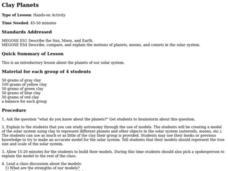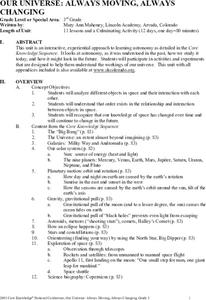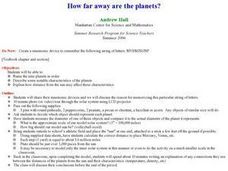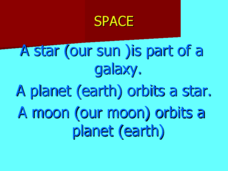Curated OER
Too Bright at Night?
Students reflect upon the causes and effects of light pollution in the night skies. First, they read articles provided and then do worksheets that are provided. They work in groups to discuss their conclusions.
Curated OER
Too Bright At Night?
Students explain what causes light pollution and how it can be curtailed. They consider the negative consequences of nighttime lighting, enabled by the invention of electric lights at the close of the 19th Century.
National Center for Case Study Teaching in Science
A Rose By Any Other Name
In part one, your astronomers read an interview dialogue between a reporter and Dr. Maria Ocasio, the chair of the group that assigns names to celestial objects. The topic in question is Pluto's status. Learners research Plutinos and...
Curated OER
Super Gelatin
Students investigate the refraction properties of gelatin to calculate its index of refraction. They discover that as the light travels through the gelatin, its speed and wavelength also change. Students find th indes of refraction of an...
Curated OER
Clay Planets
Have your class learn about the solar system using this hands on technique. Learners review what they know about the planets, and create a clay model of the solar system. There are a list of resource links to make this lesson a complete...
Curated OER
Houston, We Have a Problem! An Introductory Lesson for the unit Stars, Galaxies and the Universe
The lesson plan would make a stimulating introduction to a space unit. It is highly imaginative and suggests that the teacher darken the room to set the mood and dress as an astronaut. Teams are asked to help solve an imaginary problem...
Curated OER
Constellation Projections
Students draw constellations. In this astronomy instructional activity, students create constellations from star groupings projected on a chalk board. Students connect the "stars" to create a pattern on the board. Student can create new...
Curated OER
The Planets Moon
Students explore the theories of the creation of the universe and examine the properties of celestial bodies. They analyze the relationship between the sun, Earth and other planets. They discover the infinite potential of the science of...
Curated OER
Downloading and Viewing Images from the Internet
Twelfth graders demonstrate that they can locate and download an image from a web page.
Curated OER
Our Universe: Always Moving, Always Changing
Students explore the main concepts of astronomy through the eleven lessons of this unit. The past, present, and future methods of studying the science are examined in this unit.
Curated OER
Out of This World and Into Our Classroom
Young scholars complete a background survey on technology to determine where they need to focus on to complete this project. Using the Internet, they research a topic in Astronomy they are interested in and determine what math concepts...
Curated OER
Soil Comparison and Analysis
Students perform tests on different soil samples. In this earth science activity, students classify the soil into groups according to test results. They write a lab report following a certain criteria.
Curated OER
Hertzsprung-Russell Diagram
Learners examine the relationship between temperature and brightness. In this astronomy lesson students will correlate the evolution of stars to the HR diagram plotted.
Curated OER
Time Travel to the Edge of the Universe and Back!
Students analyze the size of the universe and calculate the time to travel to near and distant destinations.
Curated OER
The Earth in Space
Students use computer images to explain why the Earth has seasons and examine the phases of the moon. They create 3-D images and present them to the class. They answer a series of questions at the end of the lesson.
Curated OER
Planets Worksheet
In this planets worksheet, students use Internet research to complete 5 pages about solar system facts. Students answer 25 essay questions and label a diagram of the solar system.
Curated OER
Asteroid, Comet, or Meteor?
In this asteroid, comet and meteor worksheet, students complete a chart by determining which of 8 given characteristics belong to asteroids, comets or meteors.
Curated OER
Paper Plate Observation
Students analyze transits from previous scientists. They identify simple objects that could have been used for documentation in the science world. They also practice scientific inquiry using methodology.
Curated OER
How Far Away Are the Planets?
Young scholars name nine planets in order, describe some notable characteristics of the planets, explain how distance from the sun may affect these characteristics, and create solar system models.
Curated OER
Planet Interiors
Students view cut-away images of the planets' interiors, comparing and contrasting them with the Earth's in written form. Students also classify each planet as "terrestrial" or "Jovian". The Planet Interiors applet on the CSA website...
Curated OER
Illustrate the Constellations
Students research ancient Greek heroes immortalized in constellations. They choose three constellations in either the summer or winter sky to illustrate and reinforce their understanding of the northern constellations.
Curated OER
Stormy Sunspots
In this sunspots worksheet, students determine how magnetic storms on Earth are related to sunspot activity. They plot data for sunspot activity between 1967 and 1997. They compare their plotted data with the data for magnetic storms on...
Curated OER
The Reasons for the Season
Students explain the reason for the changes in season. In this lesson examining the relationship between the Earth and the Sun, students use an applet to discover how the alignment of the Earth and the Sun cause the change in seasons.
Curated OER
Basic Space
Three basic slides cover information about light years and how images of space are viewed. Some facts about light years are given and then a labeled diagram of a telescope is shown. One basic slide is included with definitions of...
Other popular searches
- Astronomy and Space Science
- Space Science Astronomy
- Science Astronomy Stars
- Earth Science Astronomy
- Science Astronomy Graphing
- Life Science Astronomy
- "Astronomy and Space Science

























